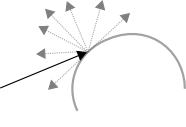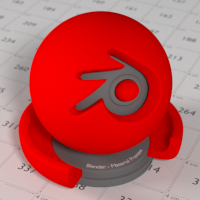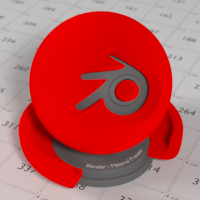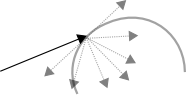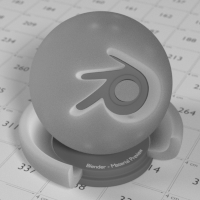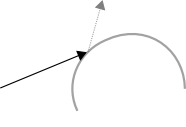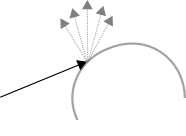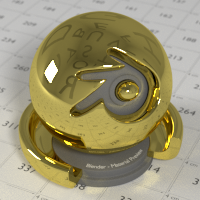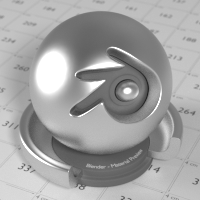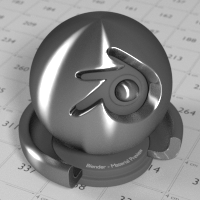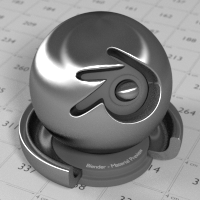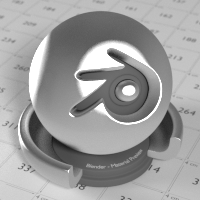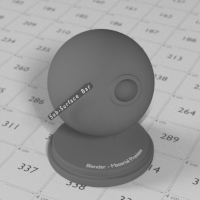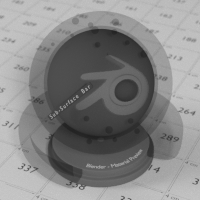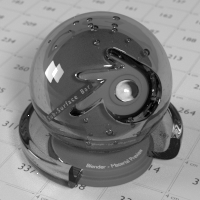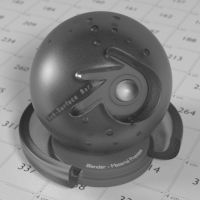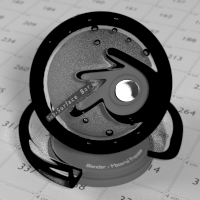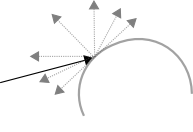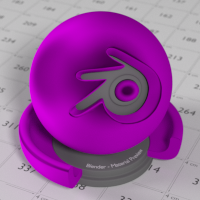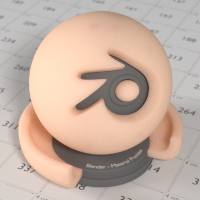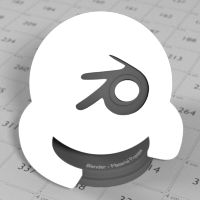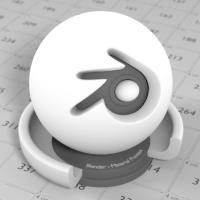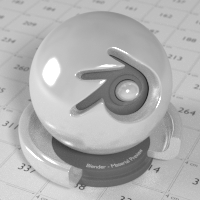Doc:2.6/Manual/Render/Cycles/Nodes/Shaders
目次
Shader Nodes
BSDF
Diffuse
Lambertian and Oren-Nayar diffuse reflection.
- Color input
- Color of the surface, or physically speaking, the probability that light is reflected or transmitted for each wavelength.
- Roughness input
- Surface roughness; 0.0 gives standard Lambertian reflection, higher values activate the Oren-Nayar BSDF.
- Normal input
- Normal used for shading; if nothing is connected the default shading normal is used.
- BSDF output
- Diffuse BSDF shader.
Translucent
Lambertian diffuse transmission.
- Color input
- Color of the surface, or physically speaking, the probability that light is transmitted for each wavelength.
- Normal input
- Normal used for shading; if nothing is connected the default shading normal is used.
- BSDF output
- Translucent BSDF shader.
Glossy
Glossy reflection with microfacet distribution, used for materials such as metal or mirrors.
- Distribution
- Microfacet distribution to use. Sharp results in perfectly sharp reflections like a mirror, while Beckmann, GGX and Ashikhmin-Shirley can use the Roughness input for blurry reflections.
- Color input
- Color of the surface, or physically speaking, the probability that light is reflected for each wavelength.
- Roughness input
- Influences sharpness of the reflection; perfectly sharp at 0.0 and smoother with higher values.
- Normal input
- Normal used for shading; if nothing is connected the default shading normal is used.
- BSDF output
- Glossy BSDF shader.
Anisotropic
Anisotropic glossy reflection, with separate control over U and V direction roughness. The tangents used for shading are derived from the active UV map. If no UV map is available, they are automatically generated using a sphere mapping based on the mesh bounding box.
- Distribution
- Microfacet distribution to use. Sharp results in perfectly sharp reflections like a mirror, while Beckmann, GGX and Ashikhmin-Shirley can use the Roughness input for blurry reflections.
- Color input
- Color of the surface, or physically speaking, the probability that light is reflected for each wavelength.
- Roughness input
- Sharpness of the reflection; perfectly sharp at 0.0 and smoother with higher values.
- Anisotropy input
- Amount of anisotropy in the reflection; 0.0 gives a round highlight. Higher values give elongated highlights orthogonal to the tangent direction; negative values give highlights shaped along the tangent direction.
- Rotation input
- Rotation of the anisotropic tangent direction. Value 0.0 equals 0° rotation, 0.25 equals 90° and 1.0 equals 360° = 0°. This can be used to texture the tangent direction.
- Normal input
- Normal used for shading; if nothing is connected the default shading normal is used.
- Tangent input
- Tangent used for shading; if nothing is connected the default shading tangent is used.
- BSDF output
- Anisotropic glossy BSDF shader.
Toon
Diffuse and Glossy Toon BSDF for creating cartoon light effects.
- Color input
- Color of the surface, or physically speaking, the probability that light is reflected for each wavelength.
- Size input
- Parameter between 0.0 and 1.0 that gives a angle of reflection between 0° and 90°.
- Smooth input
- This value specifies an angle over which a smooth transition from full to no reflection happens.
- Normal input
- Normal used for shading; if nothing is connected the default shading normal is used.
- BSDF output
- Toon BSDF shader.
Transparent
Transparent BSDF without refraction, passing straight through the surface, as if there were no geometry there. Useful with alpha maps, for example. This shader affects light paths somewhat differently than other BSDFs. Note that only pure white transparent shaders are completely transparent.
- Color input
- Color of the surface, or physically speaking, the probability for each wavelength that light is blocked or passes straight through the surface.
- BSDF output
- Transparent BSDF shader.
Glass
Glass-like shader mixing refraction and reflection at grazing angles. Like the transparent shader, only pure white will make it transparent. The glass shader tends to cause noise due to caustics. Since the Cycles path tracing integrator is not very good at rendering caustics, it helps to combine this with a transparent shader for shadows; for more details see here.
- Distribution
- Microfacet distribution to use. Sharp results in perfectly sharp refractions like clear glass, while Beckmann and GGX can use the Roughness input for rough glass.
- Color input
- Color of the surface, or physically speaking, the probability that light is transmitted for each wavelength.
- Roughness input
- Influences sharpness of the refraction; perfectly sharp at 0.0 and smoother with higher values.
- IOR input
- Index of refraction defining how much the ray changes direction. At 1.0 rays pass straight through like transparent; higher values give more refraction.
- Normal input
- Normal used for shading; if nothing is connected the default shading normal is used.
- BSDF output
- Glass BSDF shader.
Refraction
Glossy refraction with sharp or microfacet distribution, used for materials that transmit light. For best results this node should be considered as a building block and not be used on its own, but rather mixed with a glossy node using a fresnel factor. Otherwise it will give quite dark results at the edges for glossy refraction.
- Distribution
- Microfacet distribution to use. Sharp results in perfectly sharp refractions, while Beckmann and GGX can use the Roughness input for blurry refractions.
- Color input
- Color of the surface, or physically speaking, the probability that light is refracted for each wavelength.
- Roughness input
- Influences sharpness of the refraction; perfectly sharp at 0.0 and smoother with higher values.
- Normal input
- Normal used for shading; if nothing is connected the default shading normal is used.
- BSDF output
- Glossy BSDF shader.
Velvet
Velvet reflection shader for materials such as cloth. It is meant to be used together with other shaders (such as a Diffuse Shader) and isn't particularly useful on it's own.
- Color input
- Color of the surface, or physically speaking, the probability that light is reflected for each wavelength.
- Sigma input
- Variance of the normal distribution, controlling the sharpness of the peak - can be thought of as a kind of roughness.
- Normal input
- Normal used for shading; if nothing is connected the default shading normal is used.
- BSDF output
- Velvet BSDF shader.
BSSRDF
Subsurface Scattering
Simple subsurface multiple scattering, for materials such as skin, wax, marble, milk and others. For these materials, rather than light being reflect directly off the surface, it will penetrate the surface and bounce around internally before getting absorbed or leaving the surface at a nearby point.
How far the color scatters on average can be configured per RGB color channel. For example, for skin, red colors scatter further, which gives distinctive red-colored shadows, and a soft appearance.
- Falloff
- Lighting distance falloff function.
- Cubic is a sharp falloff useful for many simple materials. The function is (radius - x)3
- Gaussian gives a smoother falloff following a normal distribution, which is particularly useful for more advanced materials that use measured data that was fitted to one or more such Gaussian functions. The function is e-8x2/radius2, such that the radius roughly matches the maximum falloff distance. To match a given measured variance v, set radius = sqrt(16*v).
- Color input
- Color of the surface, or physically speaking, the probability that light is reflected for each wavelength.
- Scale input
- Global scale factor for the scattering radius.
- Radius input
- Scattering radius for each RGB color channel, the maximum distance that light can scatter.
- Normal input
- Normal used for shading; if nothing is connected the default shading normal is used.
- Texture Blur input
- How much of the texture will be blurred along with the lighting, mixing the texture at the incoming and outgoing points on the surface. Note that the right choice depends on the texture. Consider for example a texture created from a photograph of skin, in this cases the colors will already be pre-blurred and texture blur could be set to 0. Even for hand painted textures no or minimal blurring might be appropriate, as a texture artist would likely paint in softening already, one would usually not even know what an unblurred skin texture looks like, we always see it blurred. For a procedural texture on the other hand this option would likely have a higher value.
- BSSRDF output
- BSSRDF shader.
Emission
Lambertian emission, to be used for material and lamp surface outputs.
- Color input
- Color of the emitted light.
- Strength input
- Strength of the emitted light. For point and area lamps, the unit is Watts. For materials, a value of 1.0 will ensure that the object in the image has the exact same color as the Color input, i.e. make it 'shadeless'.
- Emission output
- Emission shader.
Cycles uses a physically correct light falloff by default, whereas Blender Internal uses a smoothed falloff with a Distance parameter. A similar effect can be found by using the Light Falloff node with the Smooth parameter.
Lamp strength for point, spot and area lamps is specified in Watts. This means you typically need higher values than Blender Internal, as you couldn't use a 1W lamp to light a room; you need something stronger like a 100W lamp.
Sun lamps are specified in Watts/m^2, which require much smaller values like 1 W/m^2. This can be confusing, but specifying strength in Watts wouldn't have been convenient; the real sun for example has strength 384600000000000000000000000W. Emission shaders on meshes are also in Watts/m^2.
Background
Background light emission. This node should only be used for the world surface output; it is ignored in other cases.
- Color input
- Color of the emitted light.
- Strength input
- Strength of the emitted light.
- Background output
- Background shader.
Holdout
A holdout shader is useful for compositing, to create a "hole" in the image with zero alpha transparency where the object with this shader is located.
- Holdout output
- Holdout shader.
Ambient Occlusion
The ambient occlusion node gives per-material control for the amount of AO. When AO is enabled in the world, it affects all diffuse BSDFs in the scene. With this option it's possible to let only some materials be affected by AO, or to let it influence some materials more or less than others.
- Color input
- surface reflection color.
- AO output
- Ambient Occlusion shader.
Mix and Add
Mix or add shaders together. Mixing can be used for material layering, where the Fac input may, for example, be connected to a Blend Weight node.
- Shader inputs
- Shaders to mix, such that incoming rays hit either with the specified probability in the Fac socket.
- Fac input
- Blend weight to use for mixing two shaders; at zero it uses the first shader entirely and at one the second shader.
- Shader output
- Mixed shader.
